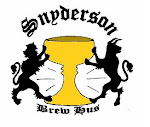
It was a long weekend but a busy one for the Brewhus. First off, we bottled the Broc Irish Stout and, frankly, this one is going to be a great one. Awesome dry stout taste with a clean finish... and that was on bottling day. A few weeks of conditioning and we will have a winner. End count: fifty-three 12oz. bottles.
Second, we uncapped Tomten's Jul Öl on Thanksgiving and it was fantastic. The aroma was full of holiday spice and the flavor was clean and magnificent. Even though we used 22oz. bombers, I expect they won't last very long. Better get 'em while they're hot (er, cold)!
Third, Friday was a brew day: Canada Goose Cream Ale. This is the second generation of this beer - that is, I previously brewed a cream ale under this label and, although it is not the exact same recipe, it should come out similar enough. Note: Brewing on day two of a four day weekend was really nice - plenty of time and no pressure. I need to find a similar weekend to do so again.
Starting gravity: 1.036
Ingredients:
6 lb. Gold LME
8 oz. Carapils specialty grains
2 oz. Cascade hops
Finally, after a solid win against our cross-town rivals, the pale ale is officially labeled Trojan Celebration Ale.
Second, we uncapped Tomten's Jul Öl on Thanksgiving and it was fantastic. The aroma was full of holiday spice and the flavor was clean and magnificent. Even though we used 22oz. bombers, I expect they won't last very long. Better get 'em while they're hot (er, cold)!
Third, Friday was a brew day: Canada Goose Cream Ale. This is the second generation of this beer - that is, I previously brewed a cream ale under this label and, although it is not the exact same recipe, it should come out similar enough. Note: Brewing on day two of a four day weekend was really nice - plenty of time and no pressure. I need to find a similar weekend to do so again.
Starting gravity: 1.036
Ingredients:
6 lb. Gold LME
8 oz. Carapils specialty grains
2 oz. Cascade hops
Finally, after a solid win against our cross-town rivals, the pale ale is officially labeled Trojan Celebration Ale.


